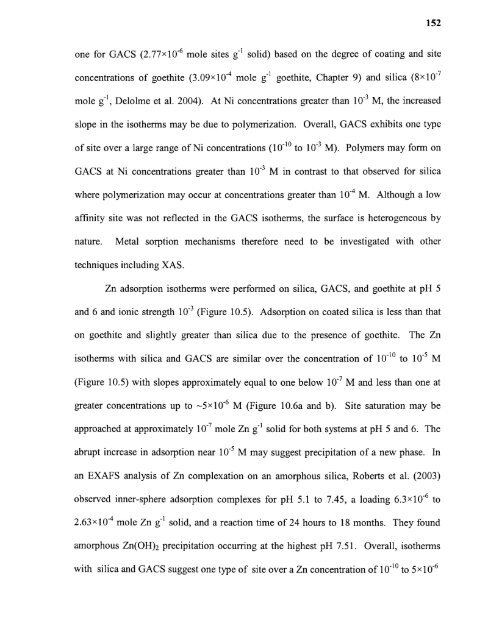Heavy metal adsorption on iron oxide and iron oxide-coated silica ...
Heavy metal adsorption on iron oxide and iron oxide-coated silica ...
Heavy metal adsorption on iron oxide and iron oxide-coated silica ...
Create successful ePaper yourself
Turn your PDF publications into a flip-book with our unique Google optimized e-Paper software.
152<strong>on</strong>e for GACS (2.77x10 -6 mole sites g -1 solid) based <strong>on</strong> the degree of coating <strong>and</strong> sitec<strong>on</strong>centrati<strong>on</strong>s of goethite (3.09x10 -4 mole g-1 goethite, Chapter 9) <strong>and</strong> <strong>silica</strong> (8x10 -7mole g -1 , Delolme et al. 2004). At Ni c<strong>on</strong>centrati<strong>on</strong>s greater than 10-3 M, the increasedslope in the isotherms may be due to polymerizati<strong>on</strong>. Overall, GACS exhibits <strong>on</strong>e typeof site over a large range of Ni c<strong>on</strong>centrati<strong>on</strong>s (10 -10 to 10 -3 M). Polymers may form <strong>on</strong>GACS at Ni c<strong>on</strong>centrati<strong>on</strong>s greater than 10 -3 M in c<strong>on</strong>trast to that observed for <strong>silica</strong>where polymerizati<strong>on</strong> may occur at c<strong>on</strong>centrati<strong>on</strong>s greater than 10 -4 M. Although a lowaffinity site was not reflected in the GACS isotherms, the surface is heterogeneous bynature. Metal sorpti<strong>on</strong> mechanisms therefore need to be investigated with othertechniques including XAS.Zn <str<strong>on</strong>g>adsorpti<strong>on</strong></str<strong>on</strong>g> isotherms were performed <strong>on</strong> <strong>silica</strong>, GACS, <strong>and</strong> goethite at pH 5<strong>and</strong> 6 <strong>and</strong> i<strong>on</strong>ic strength 10 -3 (Figure 10.5). Adsorpti<strong>on</strong> <strong>on</strong> <strong>coated</strong> <strong>silica</strong> is less than that<strong>on</strong> goethite <strong>and</strong> slightly greater than <strong>silica</strong> due to the presence of goethite. The Znisotherms with <strong>silica</strong> <strong>and</strong> GACS are similar over the c<strong>on</strong>centrati<strong>on</strong> of 10 -1° to 10 -5 M(Figure 10.5) with slopes approximately equal to <strong>on</strong>e below 10-7 M <strong>and</strong> less than <strong>on</strong>e atgreater c<strong>on</strong>centrati<strong>on</strong>s up to —5x10 -6 M (Figure 10.6a <strong>and</strong> b). Site saturati<strong>on</strong> may beapproached at approximately 10-7 mole Zn g -1 solid for both systems at pH 5 <strong>and</strong> 6. Theabrupt increase in <str<strong>on</strong>g>adsorpti<strong>on</strong></str<strong>on</strong>g> near 10 -5 M may suggest precipitati<strong>on</strong> of a new phase. Inan EXAFS analysis of Zn complexati<strong>on</strong> <strong>on</strong> an amorphous <strong>silica</strong>, Roberts et al. (2003)observed inner-sphere <str<strong>on</strong>g>adsorpti<strong>on</strong></str<strong>on</strong>g> complexes for pH 5.1 to 7.45, a loading 6.3x10 -6 to2.63x10 -4 mole Zn g-1 solid, <strong>and</strong> a reacti<strong>on</strong> time of 24 hours to 18 m<strong>on</strong>ths. They foundamorphous Zn(OH)2 precipitati<strong>on</strong> occurring at the highest pH 7.51. Overall, isothermswith <strong>silica</strong> <strong>and</strong> GACS suggest <strong>on</strong>e type of site over a Zn c<strong>on</strong>centrati<strong>on</strong> of 10 -1° to 5x10-6
















